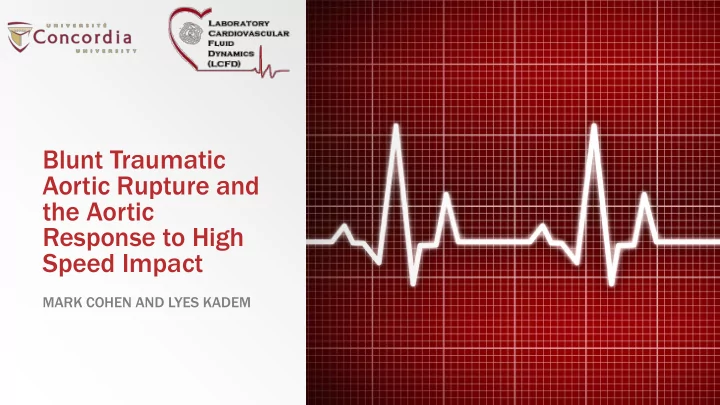

Blunt Traumatic Aortic Rupture and the Aortic Response to High Speed Impact MARK COHEN AND LYES KADEM
Blunt Traumatic Aortic Rupture (BTAR) ▪ In North America, approximately 19% of all auto accident fatalities are caused by BTAR. ▪ Second in fatalities only to Cranial Trauma, BTAR is a condition characterized by the rupture of the aorta and subsequent internal haemorrhaging due to high-speed impacts. ▪ Due to the difficulty in diagnosing this condition, patients who have been in auto accidents and who seem otherwise healthy, may die days after the fact. ▪ While the general cause for BTAR is understood to be high-speed impact, the physiological causes are scarcely understood due to the clinical and ethical constraints of human testing for such a condition. ▪ As such, we have no definitive answer to the mechanism of action of BTAR, though we do have a few theories. ▪ Aortic Stretching ▪ Shearing and Bending stresses due to aortic flexing over the pulmonary artery. Source: Branchereau and Jacobs, Vascular Emergencies Aortic “water hammer” effect ▪ Osseous Pinch ▪
OSCAR
The System Signal generation and acquisition 3D Printed Rib Cage Aorta with Pressure Probe using LabView
Test Parameters •Pulsatile Flow – Normal Pressure (120/80 mmHg) Normal Pressure Waveform 140 •Pulsatile Flow – High Pressure (160/120 120 mmHg) 100 Pressure (mmHg) •Pulsatile Flow – Low Pressure (90/50 80 60 mmHg) 40 •Continuous Flow – Normal Pressure (115 20 mmHg) 0 0 0.2 0.4 0.6 0.8 1 1.2 1.4 1.6 Time (s) •No Flow (gauge pressure 0 mmHg)
Test Procedure
Acceleration Profile Normal Pressure - Peak at Diastole - Acceleration Waveform 10 5 0 0 2 4 6 8 10 12 14 A similar acceleration -5 profile was observed for Acceleration (g) -10 all tests (±2g). Acceleration Profile -15 Max G-Force: Ma e: -28.39g .39g -20 -25 -30 -35 Time (s)
Results – Pressure Probe in the Descending Aorta ▪ The waveform shows a pressure spike to 250 mmHg at the moment of impact, and then a return to normal after approximately 4 seconds. 300 OSCAR PRESSURE WAVEFORM AT 100% SPEED 250 Before Impact After Impact 200 Pressure (mmHg) 150 100 Impact 50 0 0 1 2 3 4 5 6 7 8 9 10 Time (s)
Results – Pressure Probe in the Ascending Aorta ▪ The waveform shows a pressure spike to 326.34mmHg at the moment of impact, and then a return to normal after approximately 4 seconds. Normal Pressure Waveform - Peak at Diastole 400 Avera erage e Press essure Betwee een n 2nd and 3rd Peaks ks 150.53 mmHg 350 300 After Impact Before Impact 250 Pressure (mmHg) 200 Pressure Profile Systole Point 150 Ma Max Pressu essure: e: 326.34 .34 mmHg mmHg 100 50 Impact 0 0 1 2 3 4 5 6 7 8 9 Time (s)
Results – Pressure Comparison Comparison of Pressure Waveforms – Impact at Diastole 400 350 300 250 Pressure (mmHg) 200 Normal Pressure Profile High Pressure Profile Low Pressure Profile 150 100 50 0 0 1 2 3 4 5 6 7 8 9 10 Time (s)
Results ▪ The results below show the maximum pressure at impact, and the difference between the maximum pressure at impact and the steady state values for systolic/diastolic pressure. Test Max Pressure Mean Std. Dev. Max-S.S. Systole Mean Std. Dev. Max-S.S. Diastole Mean Std. Dev. Normal Pressure - Impact at Diastole 326 196 266 Normal Pressure - Impact at Systole 298 175 224 High Pressure - Impact at Diastole 334 168 216 312 24 183 15 233 21 High Pressure - Impact at Systole 336 170 217 Low Pressure - Impact at Diastole 274 182 224 Low Pressure - Impact at Systole 304 206 252 Max Pressure Max-Avg Test Continuous Flow - 115mmHg 310 195 No Flow 217 217
Results – No Flow vs. Normal Flow Peaks Test Impac act Peak Seco cond ndar ary Peak Tertiar ary Peak Mean n Std. . Dev. Normal mal 326 181 190 No Flow 217 74 88 No Flow and Normal Pressure - Impact at Diastole Δ( Nor ormal mal-No o Flow) ow) 109 107 102 106 3.73 350 300 250 Max Pressure (no flow): No Flow vs. Normal Flow 217.10 mmHg Pressure (mmHg) 200 350 No Flow Pressure Profile 150 300 Normal Pressure Profile Shifted No Flow 250 Pressure (mmHg) 100 Max Pressure (normal): 200 Normal Pressure Peaks 326.34 mmHg 50 150 No Flow Pressure Peaks Overlap of No Flow on Normal 0 100 -1 1 3 5 7 9 11 13 15 50 -50 Time (s) 0 1 2 3 Peak Number
350 300 250 Normal Pressure Waveform - Impact at Diastole 200 Pressure (mmHg) 150 100 50 0 2 3 4 5 6 7 8 9 Time (s)
Discussion ▪ Pressure Loss During Acceleration Phase ▪ Change in Hydrostatic Pressure and Convective Acceleration (Wikipedia) ▪ Pressure Differential Due to Aortic Volume ▪ Peak at High Pressure A Wiggers diagram, showing the cardiac cycle events occurring in the left side of the heart. (Wikipedia)
What’s Next? ▪ Continued Testing to Have a Larger Sample Size ▪ Particle Image Velocimetry ▪ Straight Tube Aortae ▪ Modification to Allow for Different Aorta Placements ▪ Deformation Measurements
Thank You
Recommend
More recommend